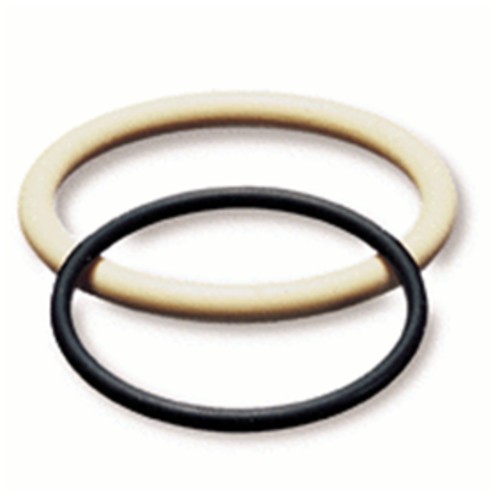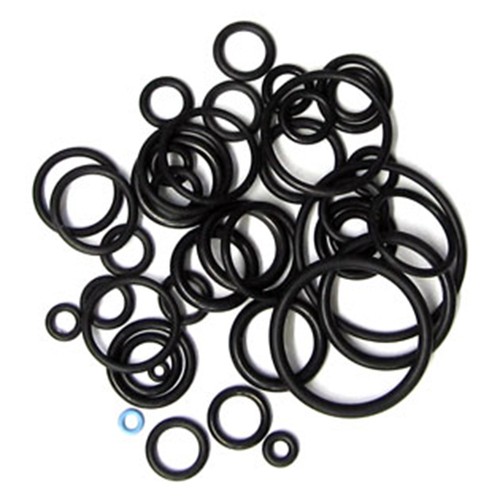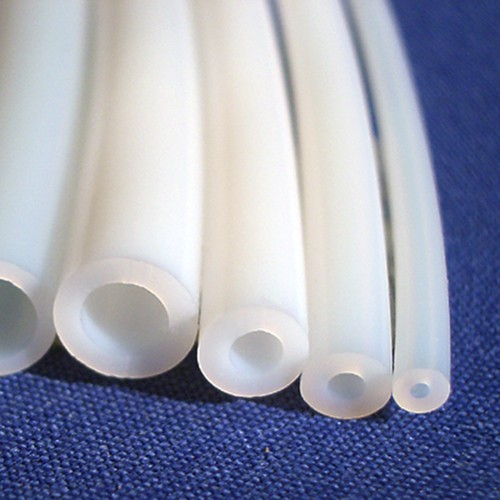High-Performance PTFE O-Rings
Application area
Very well suited for use in:
Almost all acids (hydrochloric and nitric acid), almost all bases (sodium hydroxide, potassium hydroxide), aggressive media such as alkalis, ozone (+40 °C, 200 pphm) and oxygen, polar organic solvents (e.g. acetic acid), oxidizing media (e.g. peracetic acid).
Should not be used in:
Alkali metals such as natrium, potassium or gaseous fluorine at high pressures and temperatures; applications where rubber-elastic properties of an elastomer are required.
Product specification
Food quality
Excellent chemical resistance
Very good cold and thermal resistance
Very good resistance to weather
Low aging
Non-inflammable
Technical specification
Material: PTFE (polytetrafluoroethylene)
Color: white
Shore hardness D: 56°
Temperature range: -200 to +260 °C
Density: 2.15 g/cm3 (ASTM D 4894)
Bulk density: 850 kg/m3 (DIN 53466)
Mean particle size: 220 µm (ASTM D 4894)
Tearing strength: 33 N/mm2; foil 0.2 mm (ASTM D 4894)
Elongation at break: 400 %
Ball pressure hardness: 26 N/mm2 (DIN ISO 2039-1)
Thermal conductivity: 0.35 W/m * K (DIN 52612)
Dielectric strength: 60 kV/mm; foil 0.2 mm (IEC 60243-1)
Volume resistivity: 1018 Ohm x cm (IEC 60093)
Regulations:
For the food processing industry: conforming to FDA (CFR 21 §177.2600)
Free from animal derived ingredients (ADI free)
General Information O-Rings
These O-Ring materials are specially developed for use in the food processing, pharmaceutical, petrochemical and chemical industries, as well as in technological processes
Design: O-Rings are vulcanised in moulds
Method of operation: O-Rings are double-acting sealing elements. The initial squeeze acting in a radial or axial direction due to the installation gives the O-Ring its initial sealing capability. These forces are superimposed by the system pressure to create the total sealing force which increases with increasing system pressure. Under pressure, the O-Ring behaves in a similar way to a fluid with high surface tension. The pressure is transmitted uniformly to all directions (see Figure Sealing forces).
Compared with other sealing elements, the O-Ring has a wide range of advantages: Inexpensive, allows low cost solutions; simple, one-piece groove design reduces hardware and design costs; compact design allows smaller hardware; easy, foolproof installation reduces risk; applicable to a wide range of sealing problems, static, dynamic, single or double acting; wide compound choice for compatibility with most fluids
Most common applications: Sealing of static machine parts against liquid or gaseous media; as a radial static seal, e.g. for bushings, covers, pipes, cylinders; as an axial static seal, e.g. for flanges, plates, caps; as a dynamic sealing element at axial, rotating and oscillating movements
Branch-specific sealing solutions: Approvals and conformities in the food processing industry: ADI free, FDA, 3-A; Sanitary Standards; pharmaceutical industry: ADI free, USP Class VI
Petrochemical industry: ex. decompression
Chemistry: permeation density and chemical stability
Dimensions: Inched ARP 001 - 932; Metric ID 3 - 193 mm; Cord thickness 1 - 8 mm
Manufacturing: According to the latest standards, with an optimal tool park, for quick and flexible handling, the traceability of materials is guaranteed, all parts go through a quality check before packaging
Usual application areas for elastomers regarding temperature and polarity of the used media
Approvals and certificates in the food, pharmaceutical and drinking water industries (see list of approvals)
Usual cleaning media for continuous plants in the food and pharmaceutical industries (see list of cleaning products)
| Item | Image |
Inside Ø mm
|
Schnur Ø mm
|
Einheit Stück
|
Price Euro* | Buy |
|---|
Item
|
Image
|
Inside Ø mm
|
Schnur Ø mm
|
Einheit Stück
|
Price Euro* |
Buy
|
|---|---|---|---|---|---|---|
| 409536 |
|
2,9 | 1,78 | 10 | 100.00 | |
| 409537 |
|
2,9 | 1,78 | 20 | 172.00 | |
| 409538 |
|
3,68 | 1,78 | 10 | 100.00 | |
| 409539 |
|
3,68 | 1,78 | 20 | 172.00 | |
| 409540 |
|
4,47 | 1,78 | 10 | 100.00 | |
| 409541 |
|
4,47 | 1,78 | 20 | 172.00 | |
| 409542 |
|
5,28 | 1,78 | 10 | 100.00 | |
| 409543 |
|
5,28 | 1,78 | 20 | 172.00 | |
| 409544 |
|
6,07 | 1,78 | 10 | 100.00 | |
| 409545 |
|
6,07 | 1,78 | 20 | 172.00 | |
| 409546 |
|
7,65 | 1,78 | 10 | 100.00 | |
| 409547 |
|
7,65 | 1,78 | 20 | 172.00 | |
| 409548 |
|
9,25 | 1,78 | 10 | 100.00 | |
| 409549 |
|
9,25 | 1,78 | 20 | 172.00 | |
| 409550 |
|
10,82 | 1,78 | 10 | 100.00 | |
| 409551 |
|
10,82 | 1,78 | 20 | 172.00 | |
| 409552 |
|
12,42 | 1,78 | 10 | 100.00 | |
| 409553 |
|
12,42 | 1,78 | 20 | 172.00 | |
| 409554 |
|
14 | 1,78 | 10 | 100.00 | |
| 409555 |
|
14 | 1,78 | 20 | 172.00 | |
| 409556 |
|
15,6 | 1,78 | 10 | 100.00 | |
| 409557 |
|
15,6 | 1,78 | 20 | 172.00 | |
| 409558 |
|
17,17 | 1,78 | 10 | 156.00 | |
| 409559 |
|
17,17 | 1,78 | 20 | 267.00 | |
| 409560 |
|
18,77 | 1,78 | 10 | 156.00 |






















